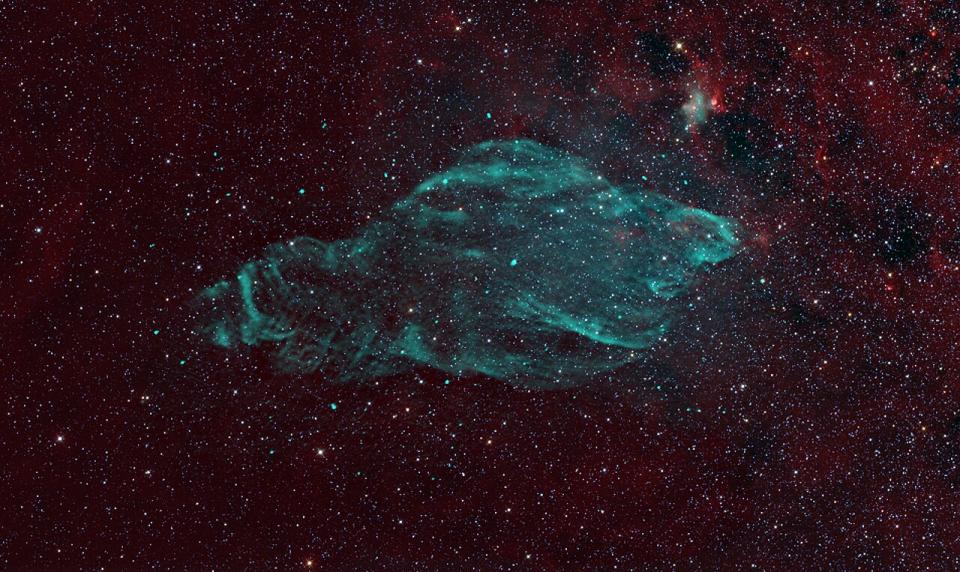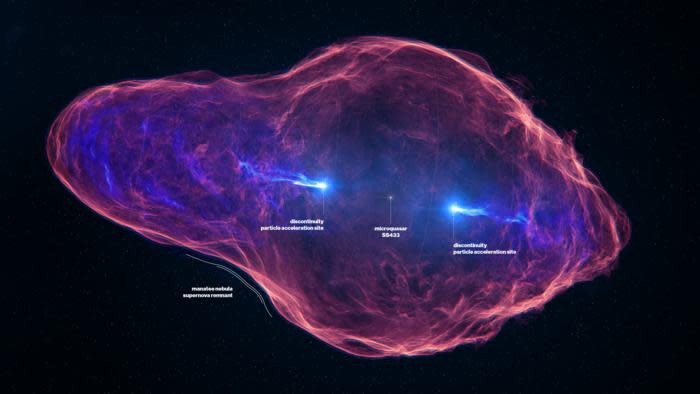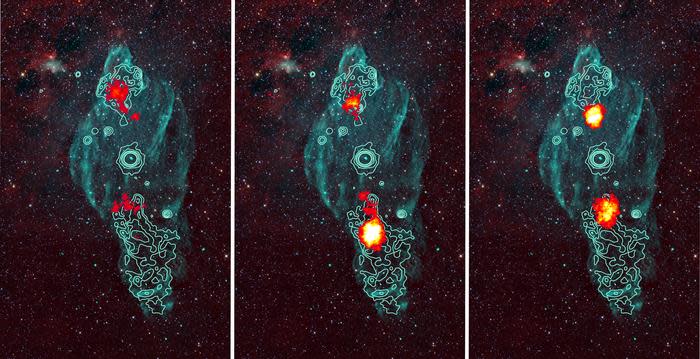Scientists may have found evidence that vampire black holes feeding on victim stars called microquasars are cosmic particle accelerators responsible for the mysterious high-energy cosmic rays we see bombarding Earth.
These stellar-mass black holes are found in binary systems with a supergiant star from which they greedily rob matter. Some of this stellar material is then directed towards the poles of the black hole, where it is ejected by high-speed relativistic jets. Microquasars get their name because they resemble quasars powered by giant supermassive black holes feeding on surrounding material, but they’re not that extreme.
First discovered in 1912, cosmic rays can hit our planet with staggering energies reaching 10²⁰ electronvolts (eV). This is much more energetic than the particles accelerated at the Large Hardon Collider, the largest and most powerful particle accelerator on Earth.
To this end, supernovae and microquasars are proposed as powerful cosmic particle accelerators of our universe. Scientists therefore believe that high-energy cosmic rays may be responsible for these phenomena. But until now there has been little evidence that microquasars accelerate particles to such high energies.
Relating to: ‘Star vampires’ may feed on stars hidden in their systems
The team established the connection between cosmic rays and microquasars by using the High Energy Stereoscopic System (HESS) to detect extremely high-energy gamma rays coming from the jets of the most powerful microquasar in the Milky Way. Its name is SS 433.
These gamma rays are created when SS 433’s jets hit surrounding matter, creating a shock front that accelerates electrons to speeds large enough to account for the particles witnessed in high-energy cosmic rays.
“The acceleration mechanism would be similar to that in a supernova remnant, but the shocks in the SS 433 jets are faster than the supernova remnant shocks and can accelerate the particles to higher energies,” said Valentí Bosch-Ramon, associate professor at the University of Barcelona. he wrote in a perspective article discussing the research published in the journal Science. “The very energetic photons detected from the large-scale jets of SS 433 are an indirect indication that such objects should not be ignored when trying to explain the most energetic nuclei in Galactic cosmic rays.”
cosmic manatee
SS 433 was actually the first microquasar ever discovered; Its existence was first revealed in 1975. Named “SS 433” after its inclusion in the 1977 catalog of celestial bodies, it later became famous when science fiction author Arthur C. Clarke named it the alternative “Seven Wonders of the World”. World.”
SS 433 lies at the heart of supernova debris called W50, nicknamed the “manatee nebula” and located about 18,000 light-years from Earth. Decades of intensive study have revealed that SS 433 consists of a black hole and a white supergiant star with a mass approximately 10 to 15 times that of the Sun. The two are approximately 15 million miles apart and orbit each other every 13 Earth days.
With no more than about a third of the distance between Mercury and the Sun between the two inhabitants of SS 433, the black hole’s immense gravity can strip away the outer layers of its star companion. While this stripped material forms an accretion disk around the black hole, some of it is actually fed into the black hole. Other parts of the material are directed towards the poles of the black hole by strong magnetic fields. From here, funnel-shaped material is ejected at approximately 26% of the speed of light.

These jets spin in a corkscrew-like pattern and are so powerful they even shape the W50.
The W50 supernova debris was formed when a massive star exploded about 20,000 years before we see it today. The microquasar inside has created two bulges, or “bumps,” that cause W50 to take on the appearance of a large cosmic manatee, hence its colorful nickname.
SS 433’s jets are visible in radio waves extending about 1 light-year on either side of their source. Eventually they lose their energy and darken to the point where they can no longer be seen. However, oddly enough, these relativistic jets suddenly reappear in high-energy X-ray light about 75 light-years from the microquasar’s origin.
The team says this suggests that something inside each jet is accelerating the particles to even higher energies and therefore to speeds higher than those they had when they were ejected from around the black hole.


Using five telescopes including HESS in Namibia, scientists investigated these strange jets from SS 433 in gamma-ray light and found that the more energetic gamma rays originated further away from the binary system.
The team found that the best explanation for this might be that high-speed, shock-accelerated electrons scatter particles of infrared light, converting them into gamma rays.
High-energy gamma rays far from the feeder black hole show two spots about 75 light-years away from SS 433’s central binary system; here the shocks reshape the jets back into a tight column, giving the particles involved a boost in energy.
This also explains the reappearance of jets in X-rays: accelerated electrons produce X-ray emissions.
“This is the first observation of energy-dependent morphology in the gamma-ray emission of an astrophysical jet,” Laura Olivera-Nieto, team leader and a scientist at the Max-Planck-Institut für Kernphysik, said in a statement. “We were initially surprised by these findings. The concentration of such high-energy photons in the regions where the X-ray jets re-emerge means that unexpectedly effective particle acceleration must occur there.”


There are still puzzles around this intriguing microquasar that the team will try to solve. This will include discovering what the jets hit to create these shocks so far from the binary system that launched them.
“We still do not have a model that can uniformly explain all the features of the jet, as no model has yet predicted this feature,” Olivera-Nieto said.
The team will also try to apply what they have learned about microquasar jets to jets emanating from more powerful supermassive black hole-supported quasars.
Related Stories:
— Strange ‘slow’ neutron star challenges our theories about dead stars
— James Webb Space Telescope detects violent collision between neutron stars
— Scientists discover ‘malfunctioning’ neutron star that destroyed an asteroid and then caused a bright explosion
While they also suggest a source for high-energy cosmic rays, these findings do not yet close the book on the age-old cosmic mystery.
“SS 433 cannot be the source of the very energetic, peta-electronvolt, cosmic ray protons detected on Earth because the source is too young for its particles to reach Earth after escaping from the source,” Bosch-Ramon wrote. “However, closer and longer-lived microquasars may contribute non-negligibly to local peta-electron volt cosmic rays, even if they are weaker and harder to detect individually.”
The team’s research was published Thursday, January 25, in the journal Science.